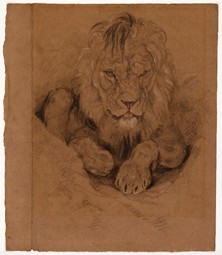Study of a Lion: Nero from Life
Sir Edwin Henry Landseer (1802-1873). Charcoal and pastel on paper, c.1820.
WorkNero the Lion was a resident of Polito's Menagerie at the Exeter Exchange on the Strand. Landseer, together with his friend John Frederick Lewis (1804-1876), visited the Menagerie from childhood and drew the animals there. Together, they produced many such sketches 'from life'.Landseer drew Nero when he was only 11 or 12 years old. This work was engraved by his brother Thomas as a print entitled 'Nero, a lion from Senegal, now exhibiting in the Tower of London'; this suggests that Polito, who occasionally toured England with the menagerie, also showed his animals at the Tower of London. Polito renamed his menagerie the 'Royal Menagerie' in 1810. Confusingly, the original 'Royal Menagerie' was still open at this time at the Tower of London.
ArtistLandseer was the most famous animal painter of the Victorian period. His father was an engraver who encouraged his drawing skills. While Landseer often drew animals from life, he also studied their anatomy by dissecting them after death. At a young age his talent was recognised by the Royal Academy of Art. He displayed works there from the age of 13. Collection of the Guild of St George, Museums Sheffield
Landseer's most popular works concerned domestic and exotic animals and hunting scenes in the Scottish Highlands. Mass-produced prints were made from many of Landseer's animal drawings. He also received a number of commissions from Queen Victoria. He painted her pets, particularly her dogs, and produced family portraits. Today, Landseer's most famous works are the four lion sculptures that surround Nelson's Column in Trafalgar Square. These were unveiled in 1868.
Ruskin on LandseerRuskin wrote that this drawing of Nero was 'an example of [Landseer's] youthful work not otherwise interesting'. More generally, Ruskin observed 'the labour, or watchfulness of nature' in Landseer's work which arose not from a love of art but 'a healthy love of Scotch Terriers'. This coincides with Ruskin's belief that artists should love their subject matter and not try drawing it without loving it first. |



















